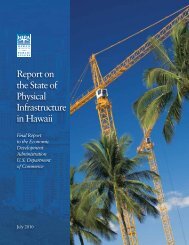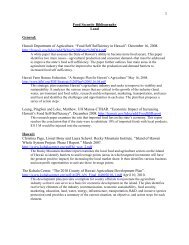Hawai'i Fisheries Initiative - The Hawaii Institute for Public Affairs
Hawai'i Fisheries Initiative - The Hawaii Institute for Public Affairs
Hawai'i Fisheries Initiative - The Hawaii Institute for Public Affairs
You also want an ePaper? Increase the reach of your titles
YUMPU automatically turns print PDFs into web optimized ePapers that Google loves.
And, adjacent to the Hualalai Resort on<br />
the Big Island, biologist David Chai has<br />
restored Waiakauhi, a rare anchialine<br />
(near the sea) fishpond. Anchialine ponds<br />
have tidal fluctuations due to subsurface<br />
connections with the oceans via cracks<br />
and crevices in lava. Chai stocks this pond<br />
with “traditional fishpond fish” such as awa<br />
(milkfish), mullet, papio (young crevalle),<br />
aholehole (<strong>Hawaii</strong>an flagtail), and manini<br />
(convict tang).” 499 Others have presented the<br />
idea of combining tourism as an economic<br />
byproduct of fishpond revitalization: “Ideal<br />
resources <strong>for</strong> fish and crustacean culture,<br />
a number of <strong>Hawaii</strong>an ponds will likely<br />
be restored <strong>for</strong> commercial culture of<br />
mullet, milkfish, threadfin and seaweeds,”<br />
wrote J.A. and C. Arki Wyban in 1989.<br />
“Fish production in these ponds could be<br />
integrated with visitor activities such as fee<br />
fishing or visitor centers.” 500<br />
On Moloka‘i, <strong>Hawaii</strong>an activist Walter Ritte<br />
has led local youth in a rebuilding ef<strong>for</strong>t<br />
of the dozens of fishponds that line the<br />
island’s south shore. On the east end of<br />
the island, the <strong>Hawaii</strong>an Learning Center<br />
fronts a restored 54-acre fishpond called<br />
Keawanui, from which thousands of<br />
pounds of fish are harvested annually. HLC<br />
offers a curriculum called Kahea Loko to<br />
educate school children and others in the<br />
community interested in ancient <strong>Hawaii</strong>an<br />
land and ocean stewardship.<br />
Ancient <strong>Hawaii</strong>an<br />
Fishponds<br />
Six major types of ancient <strong>Hawaii</strong>an<br />
fishponds have been identified:<br />
n Loko wai was a freshwater pond.<br />
n A loko i‘a kalo was a combination of a taro<br />
patch and a fishpond.<br />
n A loko pu‘uone was a pond isolated from<br />
the sea either by a sand ridge, a lava flow,<br />
or a limestone <strong>for</strong>mation. It contained either<br />
brackish water or a combination of brackish<br />
water and fresh water.<br />
n A loko kuapa is a shore pond enclosed by a<br />
rock wall (kuapa) broken by a ditch (‘auwai)<br />
or one or more sluice gates (makaha). <strong>The</strong><br />
makaha was used to regulate the flow of water<br />
and it also allowed the fingerlings (young fish)<br />
to enter the pond.<br />
n A loko ‘umeiki was a fishtrap and was<br />
similar to loko kuapa in construction. <strong>The</strong><br />
loko ‘umeiki had several lanes that were<br />
walled on both sides and either led in or<br />
out of the pond. Loko kuapa and loko<br />
‘umeiki were found mostly on O‘ahu and<br />
Moloka‘i because their fringing reef had<br />
shallow water and wave protected areas.<br />
n Natural pools or ponds that are found<br />
along the rocky shores were also used and<br />
occasionally modified by the <strong>Hawaii</strong>ans.<br />
A kaheka gets its water from high waves<br />
while a hapunapuna is fed by springs. 501<br />
100







